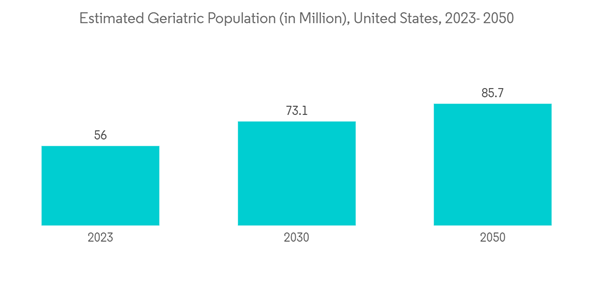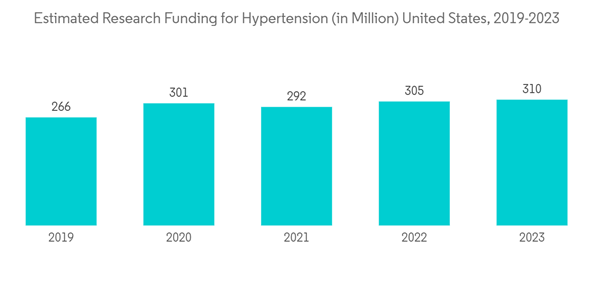The COVID-19 pandemic significantly impacted the North American hemodynamic monitoring market. Patients with COVID-19 respiratory failure showed a marked rise in blood pressure over time, not accompanied by distinctive markers of circulatory failure. For instance, according to the study published by the National Library of Medicine, in May 2022, comparing cardiac cases in COVID-19 to respiratory cases, cardiac injuries were documented in 19.7% to 29.8% of the patients. Numerous pathways contributed to the involvement of the cardiac myocardium in COVID-19, and up to 20%-30% of hospitalized patients exhibit this involvement, such as high troponin levels. This increased demand for hemodynamic monitors during the pandemic to assess critically ill patients admitted for COVID-19. Furthermore, the postponed treatment procedures and surgeries were resumed worldwide as the COVID-19 cases declined and pandemic restrictions were uplifted. This led to an increase in cardiac surgeries, creating a huge demand for hemodynamic monitoring. For instance, according to an article published by the Journal of the American College of Cardiology, in May 2022, there was a modest (3%-13%) increase in cardiac procedure volumes from pre-pandemic to 2021, associated with recovery rates of 105% to 119% in the United States and Canada. Hence, the COVID-19 pandemic has had a significant impact on market growth.
The key factors propelling the growth of this market are an increase in the number of critically ill geriatric cases, a rise in the prevalence of cardiac disorders and diabetes, increasing demand for home-based and non-invasive monitoring systems, and an increase in the number of people suffering from hypertension. For instance, as per the Heart&Stroke report of 2022, more than 750,000 people were living with heart failure in Canada in 2022, with over 106,000 new cases every year. Hence, for proper diagnosis and treatment of heart-related diseases, hemodynamic monitoring plays an important role which is likely to drive the market growth over the forecast period. Furthermore, according to American Heart Association data updated in July 2022, the number of elderly patients with calcific aortic stenosis is projected to more than double by 2050 in the United States. Thus, the demand for hemodynamic monitoring is likely to increase with the number of critically ill geriatric patients which is expected to promote market growth in North America.
Additionally, various strategies adopted by the key market players such as product launches, mergers and acquisitions are anticipated to drive the market over the forecast period. For instance, in April 2021, Spacelabs Healthcare, a division of OSI Systems, Inc. was awarded a three-year Premier agreement for physiological patient monitoring and non-invasive cardiology solutions in the United States. Such development is expected to propel the market growth in North America.
Hence, the abovementioned factors are attributed collectively to the market growth. However, increasing incidences of complications associated with invasive monitoring systems and stringent FDA guidelines for approval of new systems are the major factors restraining the market growth.
North America Hemodynamic Monitoring Market Trends
Non-invasive Monitoring Systems is Expected to hold Significant Market Share in the System Segment
Non-invasive monitoring systems include a standard five-lead electrocardiogram, non-invasive BP measurement, pulse oximetry, and capnography along with the nasopharyngeal and bladder temperature. Factors such as an increasing number of geriatric populations and a growing number of heart diseases are anticipated to stimulate the demand for non-invasive monitoring systems. For instance, according to the U.S. Census Bureau 2021 update, more than 54 million adults of age group 65 and older were living in the United States in 2021, accounting for about 16.5% of the total United States population. Such an increase in the geriatric population is expected to drive the market's growth over the forecast period.Additionally, the increasing initiatives, product launches, and strategies by the government and market players are expected to contribute to market growth. For instance, in March 2021, Fifth EyeTM, a provider of intuitive real-time clinical analytics announced that it has received U.S. Food and Drug Administration (FDA) De Novo classification for its Analytic for Hemodynamic Instability (AHI). AHI provides reliable, noninvasive, and continuous monitoring of hemodynamic decompensation through ECG waveform analysis instead of intermittent static vital signs to identify at-risk patients across hospital settings, including remotely. Such an initiative is expected to drive the market growth over the forecast period.
United States is Expected to Show a Significant Growth of the Market Over the Forecast Period
The United States is expected to grow significantly in the overall North America hemodynamic monitoring market throughout the forecast period. The growth may be attributed to the rising incidence of cardiovascular diseases, well-established insurance policies, and the availability of advanced healthcare infrastructure. For instance, according to the CDC data reviewed in October 2022, for every 40 seconds, a heart attack occurs in the United States. It also stated that about 805,000 Americans experience a heart attack each year. Hence, the rising burden of cardiovascular diseases in the coming years is likely to create demand for hemodynamic monitoring devices thereby aiding to market growth.Additionally, various initiatives taken by the key market players such as product launches, clearance, mergers, acquisitions, and partnerships are expected to boost the market growth in the United States. For instance, in September 2021, Caretaker Medical landed FDA clearance for its blood pressure and hemodynamic patient monitoring system VitalStream. Thus, owing to the above factors, the segment is expected to show a healthy growth rate over the forecast period.
North America Hemodynamic Monitoring Industry Overview
The North American hemodynamic monitoring market is moderately concentrated in nature due to the presence of companies operating globally as well as regionally. The competitive landscape includes an analysis of companies, including Getinge Group, Koninklijke Philips NV, Edwards Life Sciences Corporation, and GE Healthcare.Additional Benefits:
- The market estimate (ME) sheet in Excel format
- 3 months of analyst support
This product will be delivered within 2 business days.
Table of Contents
Companies Mentioned (Partial List)
A selection of companies mentioned in this report includes, but is not limited to:
- Koninklijke Philips NV
- Getinge Group
- Edwards Lifesciences Corporation
- GE Healthcare
- ICU Medical Inc
- Cheetah Medical Inc
- LiDCO Group PLC
- Tensys Medical Inc
- Schwarzer Cardiotek GmbH
- Draeger Medical










